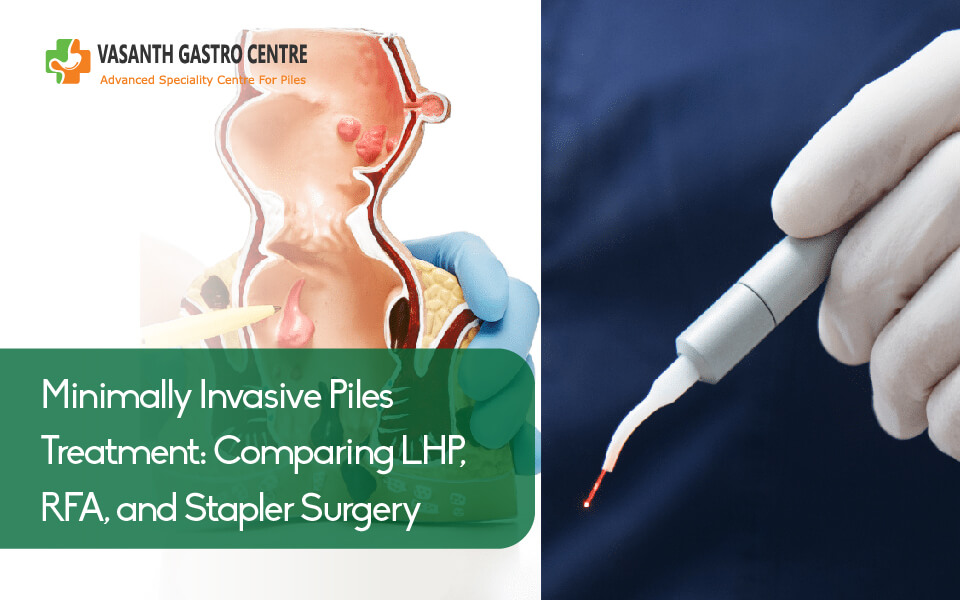Minimally Invasive Piles Treatment: Comparing LHP, RFA, and Stapler Surgery
Minimally invasive procedures have changed piles (hemorrhoids) management — offering less pain, faster recovery and excellent outcomes compared to older open surgeries. This guide compares the three commonly used minimally invasive options: LHP (Laser Hemorrhoidoplasty), RFA (Radiofrequency Ablation), and Stapler Hemorrhoidopexy (PPH), so you can understand which might be suitable for you.
1. LHP — Laser Hemorrhoidoplasty
What it is: LHP uses a laser fiber inserted into the hemorrhoidal plexus to coagulate and shrink the hemorrhoidal cushions while preserving the mucosa and sphincter.
Best for: Grade II–III hemorrhoids, patients who want quick recovery and minimal post-op pain.
- Benefits: Minimal bleeding, less postoperative pain, office/daycare procedure, quick return to daily activities.
- Risks: Rare thermal injury if improperly used, mild transient discomfort.
- Recovery: Most patients return to work within 24–72 hours. Stool softeners and high-fiber diet recommended.
2. RFA — Radiofrequency Ablation
What it is: Radiofrequency energy is applied to hemorrhoidal tissue to cause controlled ablation and subsequent fibrosis which reduces the hemorrhoid size and bleeding.
Best for: Grade II–III hemorrhoids, patients with bleeding or symptomatic cushions wanting sphincter-sparing therapy.
- Benefits: Low pain levels, targeted tissue effect, quick procedure often under local/regional anesthesia, good hemostasis.
- Risks: Rare post-op thrombosis, transient urinary retention in some patients.
- Recovery: Return to normal activity typically within 2–4 days; follow-up for diet and bowel management.
3. Stapler Hemorrhoidopexy (PPH / Stapler Surgery)
What it is: Using a circular stapling device, prolapsed hemorrhoidal tissue is resected and the remaining tissue is repositioned higher in the anal canal (above the pain-sensitive dentate line).
Best for: Prolapsed internal hemorrhoids (Grade III, early Grade IV) where repositioning rather than excision is preferred.
- Benefits: Less pain than conventional hemorrhoidectomy, shorter hospital stays, effective for prolapse.
- Risks: Rare but serious complications reported (stapler misfire, pelvic sepsis, severe bleeding) — careful case selection & experienced surgeon essential.
- Recovery: Most patients resume daily activities in 5–10 days; avoid heavy lifting for 2–4 weeks.
How the Procedures Compare — Quick Table
| Feature | LHP (Laser) | RFA | Stapler (PPH) |
|---|---|---|---|
| Pain (relative) | Low | Low | Moderate |
| Recovery Time | 24–72 hrs | 2–4 days | 5–10 days |
| Best For | Bleeding, small prolapse | Bleeding, symptomatic cushions | Prolapsed hemorrhoids |
| Recurrence | Low to moderate | Low to moderate | Low (if selected correctly) |
| Hospital Stay | Daycare | Daycare/short stay | Short stay (same day or overnight) |
Which Option Is Right for You?
Choosing between LHP, RFA and Stapler depends on:
- Grade and type of hemorrhoids (bleeding vs. prolapse)
- Your general health and anesthesia tolerance
- Recovery expectations and work/responsibilities
- Surgeon experience and available equipment
A clinic consultation with physical exam and, if needed, proctoscopy helps determine the best individualized treatment plan.
Preparing for Minimally Invasive Piles Treatment
- Pre-op evaluation and blood tests.
- Bowel preparation as advised by your surgeon.
- Discuss anticoagulants and medications with your doctor.
Post-Op Care & Recovery Tips
- High-fiber diet and 2–3 litres of water daily to avoid constipation.
- Use stool softeners as prescribed.
- Warm sitz baths for 10–15 minutes to reduce discomfort.
- Avoid heavy lifting for the recommended period.
Risks & When to Seek Help
Minor bleeding, mild discomfort and temporary urinary retention are common early after treatment. Seek immediate care if you experience:
- Heavy or persistent bleeding
- Fever or signs of infection
- Severe pain not controlled with prescribed medications
“Minimally invasive techniques like LHP and RFA have transformed piles management — less pain, faster recovery, and excellent patient satisfaction when matched correctly to the patient.”
Costs & Practical Considerations
Costs vary by procedure, hospital facility, anesthesia type and whether any additional tests are needed. Laser and RFA are typically daycare procedures and can be cost-effective due to faster return to work. For accurate pricing, contact our clinic for a personalized quote.
